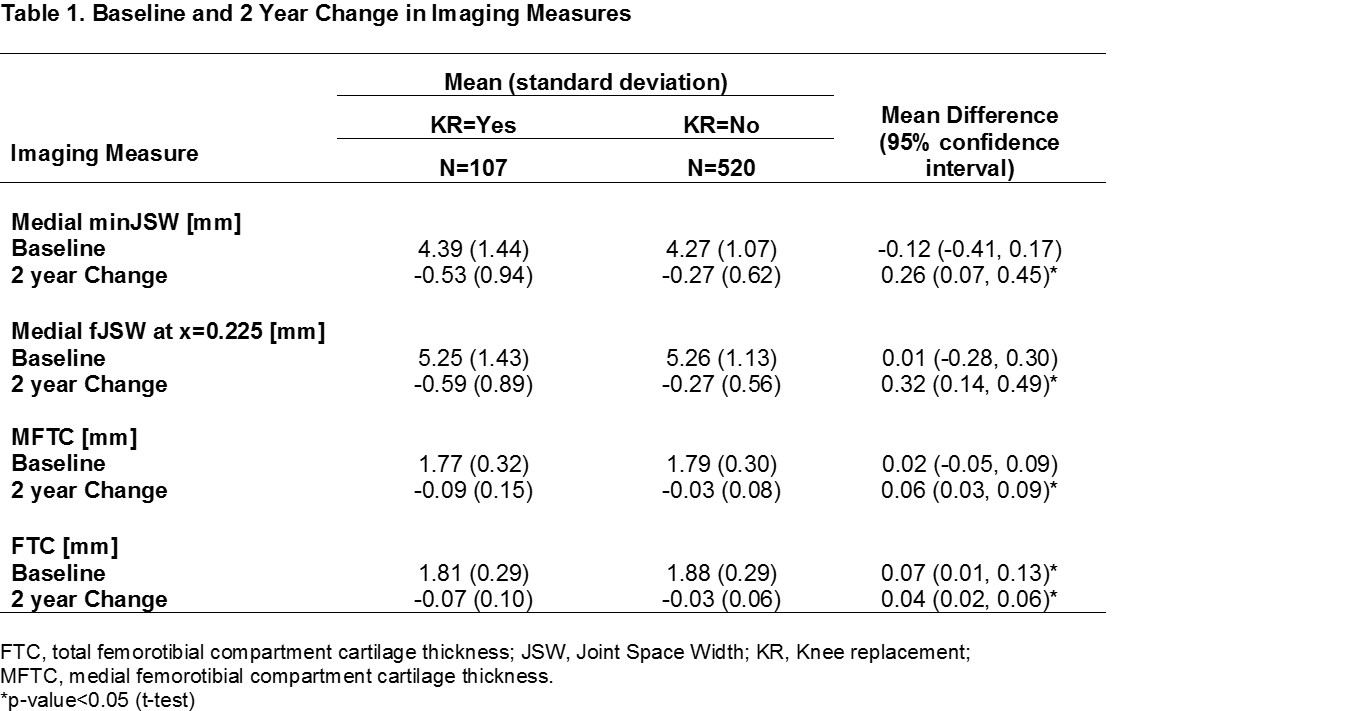Session Information
Date: Monday, November 6, 2017
Title: Osteoarthritis – Clinical Aspects Poster I: Clinical Trials and Interventions
Session Type: ACR Poster Session B
Session Time: 9:00AM-11:00AM
Background/Purpose: Structural measures of knee OA (KOA) progression include assessment of radiographic joint space width (JSW) and quantitative MRI (qMRI) measurement of cartilage thickness, both of which are endpoints in clinical trials of Disease-modifying Osteoarthritis Drugs (DMOADs). Objectives were 1) to determine if baseline value and 2 year change of medial JSW, and medial and total femorotibial compartment cartilage thickness (MFTC, FTC), are discriminative of the risk of knee replacement (KR); and 2) to evaluate whether these associations differ by sex or Kellgren-Lawrence grade (KLG).
Methods: Osteoarthritis Initiative (OAI) knees were selected based on eligibility criteria typical of a DMOAD trials for KOA: KLG of 2 or 3; medial minimum JSW (minJSW) ≥ 2.5 mm; knee pain at worst in the past 30 days from 4 to 9 on a 10-point scale, or 0 to 3 if pain medication was taken for joint pain; and availability of structural measures over two years. T-tests were used to look for differences in these measures by KR. Area under the receiver operating characteristic curve (AUC) was estimated for each measure using baseline and 2-year change values, in all patients as well as in male/female and in KLG=2/KLG=3 subgroups, to assess the ability of these measures to discriminate knees that went to future KR.
Results: The sample included 627 participants, of which 107 underwent KR, with a median of 6.7 years of follow-up. The 2-year reductions from baseline in all imaging measures were significantly greater in participants who later underwent KR compared with those who did not [Table 1]. Among all participants, the ability of JSW and cartilage thickness to discriminate knees that had future KR was modest (max AUC=0.62); the best discrimination using baseline or 2 year change values was achieved with FTC. Among subgroups, AUCs for 2 year change tended to be numerically higher for males and KLG=2, and pronounced more for fJSW and FTC [Table 2].
Conclusion: 2-year changes in all image measures were important in discriminating knees that will undergo KR. Sex and KLG should be considered as factors in discrimination ability.
To cite this abstract in AMA style:
Kwoh CK, Guehring H, Hannon MJ, Aydemir A. Clinical Relevance of Structural Measures in Knee Osteoarthritis: Baseline Values and Change from Baseline Discriminate Patients Subsequently Receiving Knee Replacement [abstract]. Arthritis Rheumatol. 2017; 69 (suppl 10). https://acrabstracts.org/abstract/clinical-relevance-of-structural-measures-in-knee-osteoarthritis-baseline-values-and-change-from-baseline-discriminate-patients-subsequently-receiving-knee-replacement/. Accessed .« Back to 2017 ACR/ARHP Annual Meeting
ACR Meeting Abstracts - https://acrabstracts.org/abstract/clinical-relevance-of-structural-measures-in-knee-osteoarthritis-baseline-values-and-change-from-baseline-discriminate-patients-subsequently-receiving-knee-replacement/


